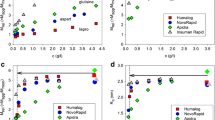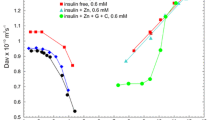Abstract
Purpose. The purpose of the current study was to investigate the effects of two important excipients, zinc and m-cresol, on the self-association properties of a series of monomeric insulin analogs. In this way, the effects on formulation behavior of individual amino acid substitutions in the C-terminal region of the insulin B-chain could be compared.
Methods. The self-association of ten insulin analogs was monitored by equilibrium and velocity analytical ultracentrifugation under three different conditions: (i) in neutral buffer alone; (ii) in neutral buffer containing zinc ion; and (iii) in neutral buffer containing both zinc ion and phenolic preservative (a typical condition for insulin formulations). The self-association properties of these analogs were compared to those of human insulin and the rapid-acting insulin analog LysB28ProB29-human insulin.
Results. The analogs in the current study exhibited a wide range of association properties when examined in neutral buffer alone or in neutral buffer containing zinc ion. However, all of these analogs had association properties similar to human insulin in the presence of both zinc and m-cresol. Under these formulation conditions each analog had an apparent sedimentation coefficient of s* = 2.9−3.1 S, which corresponds to the insulin hexamer.
Conclusions. Analogs with changes in the B27−B29 region of human insulin form soluble hexamers in the presence of both zinc and m-cresol, and m-cresol binding overrides the otherwise destabilizing effects of these mutations on self assembly.
Similar content being viewed by others
REFERENCES
A. E. Mark and P. D. Jeffrey. The self-association of zinc-free bovine insulin. Biol. Chem. Hoppe-Seyler 371:1165–1174 (1990).
A. H. Pekar and B. H. Frank. Conformation of proinsulin. A comparison of insulin and proinsulin self-association at neutral pH. Biochemistry 11:4013–4016 (1972).
E. N. Baker, T. L. Blundell, J. F. Cutfield, S. M. Cutfield, E. J. Dodson, G. G. Dodson, D. M. Crowfoot Hodgkin, R. E. Hubbard, N. W. Isaacs, C. D. Reynolds, K. Sakabe, N. Sakabe, and N. M. Vijayan. The structure of 2Zn pig insulin crystals at 1.5Å resolution. Phil. Trans. Royal Soc. London 319:369–456 (1988).
A. Wollmer, B. Rannefeld, B. R. Johansen, K. R. Hejnaes, P. Balschmidt, and F. B. Hansen. Phenol-promoted structural transformation of insulin in solution. Biol. Chem. Hoppe-Seyler 368:903–911 (1987).
U. Derewenda, Z. Derewenda, E. J. Dodson, G. G. Dodson, C. D. Reynolds, G. D. Smith, C. Sparks, and D. Swenson. Phenol stabilizes more helix in a new symmetrical zinc insulin hexamer. Nature 338:594–596 (1989).
J. Brange, L. Langkjær, S. Havelund, and A. Vølund. Chemical stability of insulin. I. Hydrolytic degradation during storage of pharmaceutical preparations. Pharm. Res. 9:715–726 (1992).
J. Brange. Stability of Insulin: Studies on the physical and chemical stability of insulin in pharmaceutical formulation. Kluwer Academic Publishers, Dordrecht, The Netherlands, 1994.
S. Rahuel-Clermont, C. A. French, N. C. Kaarsholm, and M. F. Dunn. Mechanisms of stabilization of the insulin hexamer through allosteric ligand interactions. Biochemistry 36:5837–5845 (1997).
J. Brange, U. Ribel, J. F. Hansen, G. Dodson, M. T. Hansen, S. Havelund, S. G. Melberg, F. Norris, K. Norris, L. Snel, A. R. Sørensen, and H. O. Voigt. Monomeric insulins obtained by protein engineering and their medical implications. Nature 333:679–682 (1988).
D. N. Brems, L. A. Alter, M. J. Beckage, R. E. Chance, R. D. DiMarchi, L. K. Green, H. B. Long, A. H. Pekar, J. E. Shields, and B. H. Frank. Altering the association properties of insulin by amino acid replacement. Prot. Engineer. 5:527–533 (1992).
S. Kang, J. Brange, A. Burch, A. Vølund, and D. R. Owens. Subcutaneous insulin absorption explained by insulin's physicochemical properties. Diab. Care 14:942–948 (1991).
L. Heinemann, T. Heise, L. N. Jorgensen, and A. A. R. Starke. Action profile of the rapid acting insulin analog: Human insulin B28Asp. Diabetic Med. 10:535–539 (1993).
R. D. DiMarchi, R. E. Chance, H. B. Long, J. E. Shields, and L. J. Slieker. Preparation of an insulin with improved pharmacokinetics relative to human insulin through consideration of structural homology with insulin-like growth factor I. Hormone Res. 41(suppl 2):93–96 (1994).
J. M. Radziuk, J. C. Davies, W. S. Pye, J. E. Shields, R. D. DiMarchi, and R. E. Chance. Bioavailability and bioeffectiveness of subcutaneous human insulin and two of its analogs—LysB28ProB29-human insulin and AspB10LysB28ProB29-human insulin—assessed in a conscious pig model. Diabetes 46:548–556 (1997).
J. Brange, S. Havelund, E. Hommel, E. Sørensen, and C. Kühl. Neutral insulin solutions physically stabilized by addition of Zn2+. Diabetic Med. 3:532–536 (1986).
J. Brange, L. Andersen, E. D. Laursen, G. Meyn, and E. Rasmussen. Toward understanding insulin fibrillation. J. Pharm. Sci. 86:517–525 (1997).
D. C. Howey, R. R. Bowsher, R. L. Brunelle, and J. R. Woodworth. [LysB28ProB29]-human insulin: A rapidly absorbed analogue of human insulin. Diabetes 43:396–402 (1994).
E. Ciszak, J. M. Beals, B. H. Frank, J. C. Baker, N. D. Carter, and G. D. Smith. Role of C-terminal B-chain residues in insulin assembly: the structure of hexameric LysB28ProB29-human insulin. Structure 3:615–622 (1995).
D. L. Bakaysa, J. Radziuk, H. A. Havel, M. L. Brader, S. Li, S. W. Dodd, J. M. Beals, A. H. Pekar, and D. N. Brems. Physicochemical basis for the rapid time-action of LysB28ProB29-insulin: Dissociation of a protein-ligand complex. Prot. Sci. 5:2521–2531 (1996).
D. T. Birnbaum, M. A. Kilcomons, M. R. DeFelippis, and J. M. Beals. Assembly and dissociation of human insulin and LysB28ProB29-insulin hexamers: A comparison study. Pharm. Res. 14:25–36 (1997).
T. Kubiak and D. Cowburn. Enzymatic semisynthesis of porcine despentapeptide (B26-30) insulin using unprotected desoctapeptide (B23-30) insulin as a substrate. Int. J. Peptide Prot. Res. 27:514–521 (1986).
W. W. Bromer and R. E. Chance. Preparation and characterization of desoctapeptide-insulin. Biochim. Biophys. Acta 133:219–223 (1967).
R. E. Chance, J. A. Hoffmann, E. P. Kroeff, M. G. Johnson, E. W. Schirmer, W. W. Bromer, M. J. Ross, and R. Wetzel. The production of human insulin using recombinant DNA technology and a new chain combination procedure. In D. H. Rich and E. Gross (eds). Peptides: Synthesis, Structure and Function; Proceedings of the Seventh American Peptide Symposium, Pierce Chemical Co., Rockford, 1981, pp. 721–728.
W. Stafford. Methods for obtaining sedimentation coefficient distributions. In S. Harding, A. Rowe, and J. Horton (eds). Analytical Ultracentrifugation in Biochemistry and Polymer Science, Royal Society of Chemistry, Cambridge, 1992, pp. 359–393.
W. Stafford. Boundary analysis in sedimentation transport experiments: a procedure for obtaining sedimentation distributions using the time derivative of the concentration profile. Anal. Biochem. 203:295–301 (1992).
L. J. Sleiker, G. S. Brooke, R. D. DiMarchi, D. B. Flora, L. K. Green, J. A. Hoffmann, H. B. Long, L. Fan, J. E. Shields, K. L. Sundell, P. L. Surface, and R. E. Chance. Modifications in the B10 and B26–30 regions of the B chain of human insulin alter affinity for the human IGF-1 receptor more than for the insulin receptor. Diabetologia 40(suppl 2):S54–S61 (1997).
S. Hvidt. Insulin association in neutral solutions studied by light scattering. Biophys. Chem. 39:205–213 (1991).
G. G. Dodson, E. J. Dodson, J. P. Turkenburg, and X. Bing. Molecular recognition in insulin assembly. Mol. Recog. 21:609–614 (1993).
J. Brange. The new era of biotech insulin analogs. Diabetologia 40(suppl 2):S48–S53 (1997).
Author information
Authors and Affiliations
Rights and permissions
About this article
Cite this article
Richards, J.P., Stickelmeyer, M.P., Flora, D.B. et al. Self-Association Properties of Monomeric Insulin Analogs Under Formulation Conditions. Pharm Res 15, 1434–1441 (1998). https://doi.org/10.1023/A:1011961923870
Issue Date:
DOI: https://doi.org/10.1023/A:1011961923870




